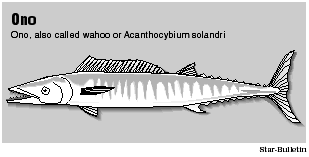Published in the Ocean Watch column, Honolulu Star-Advertiser © Susan Scott
July 9, 1997
I didn’t have to wonder what to write about in my column today. Ono, the gamefish also called wahoo, have been tapping me on the shoulder all week asking for some space.
I hadn’t thought about ono for ages until my partner Craig, an emergency room doctor, told me about an unusual case he had recently. A fisherman came in with a bad bite on the foot and ankle inflicted by a 25-pound ono.
“In the water?” I asked, picturing the fish swimming after the guy.
“No, no. In the guy’s boat. After he landed it, the fish thrashed around and bit him. It was pretty bad. It took a lot of stitches to close it up … a lot of stitches.”
A couple of days later, we ran into a fisherman friend and told the ER story. “I didn’t know ono could hurt you like that,” I said.

“Oh sure,” he said. “Those fish have teeth like razors. I’ve heard of them cutting a person even after the fish is dead. You barely have to touch those razor teeth to get injured.”
Imagining rows of shiny little razor blades, I wondered what those sharp teeth looked like.
I didn’t have to wonder long. Later that week, Craig and I were strolling through the Ala Wai Boat Harbor when we were stopped in our tracks.
There in the back of a pickup were four freshly caught ono, about 25 pounds each. They were dead, but one had its mouth wide open.
We leaned close. The teeth were not metal rectangles; they were tiny white triangles, closely set and scalpel sharp.
“Hello?” said the owner of the truck, wondering what we were doing.
“We’re admiring your catch,” I told him. “These fish have pretty fierce-looking teeth.”
“Like razors,” he said.
“So we’ve heard.”
“They’re also good to eat,” he added. “That’s why they call them ono.”
To newcomers, the word ono also means delicious in Hawaiian. And these fish have good reason to be delicious: They’re close relatives of tunas and mackerels. You can easily see the family resemblance of all these fish in the tiny finlets on the upper and lower side of the bodies, just ahead of the tail.
Ono are distinct in the family for their narrow bodies, up to 6 feet long, and sharp-pointed heads.
These strong, fast-swimming meat-eaters feed on squid and other fish. Ono have been known to take bites from the sides of tunas.
Anglers fish for ono in Hawaii’s channels where these fish swim alone near the surface.
Ono are found throughout the world’s tropical and subtropical waters. The world record for ono is 149 pounds, caught in the Bahamas in 1962. Most catches, however, are around 20 to 30 pounds.
I hope ono haven’t yet finished demanding my attention. I’d now like to see one on a menu.